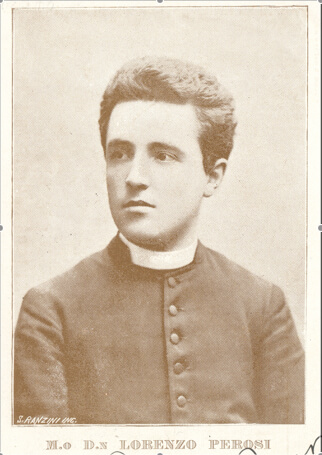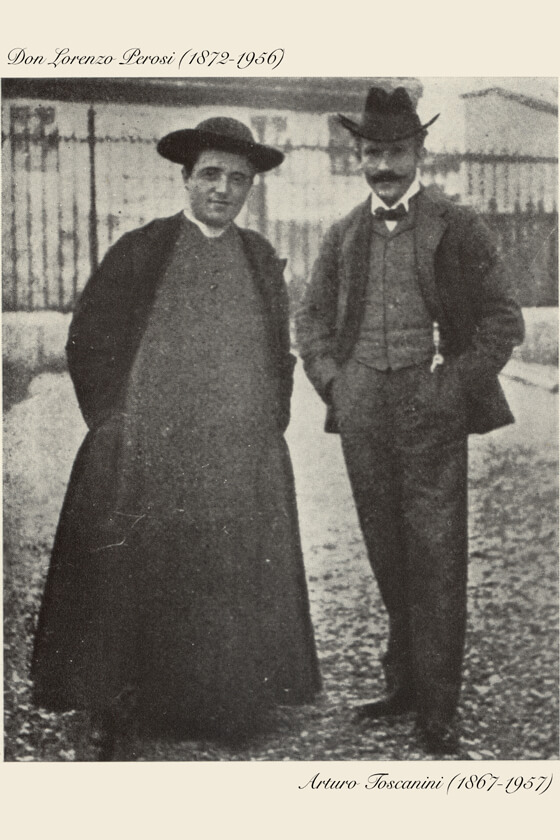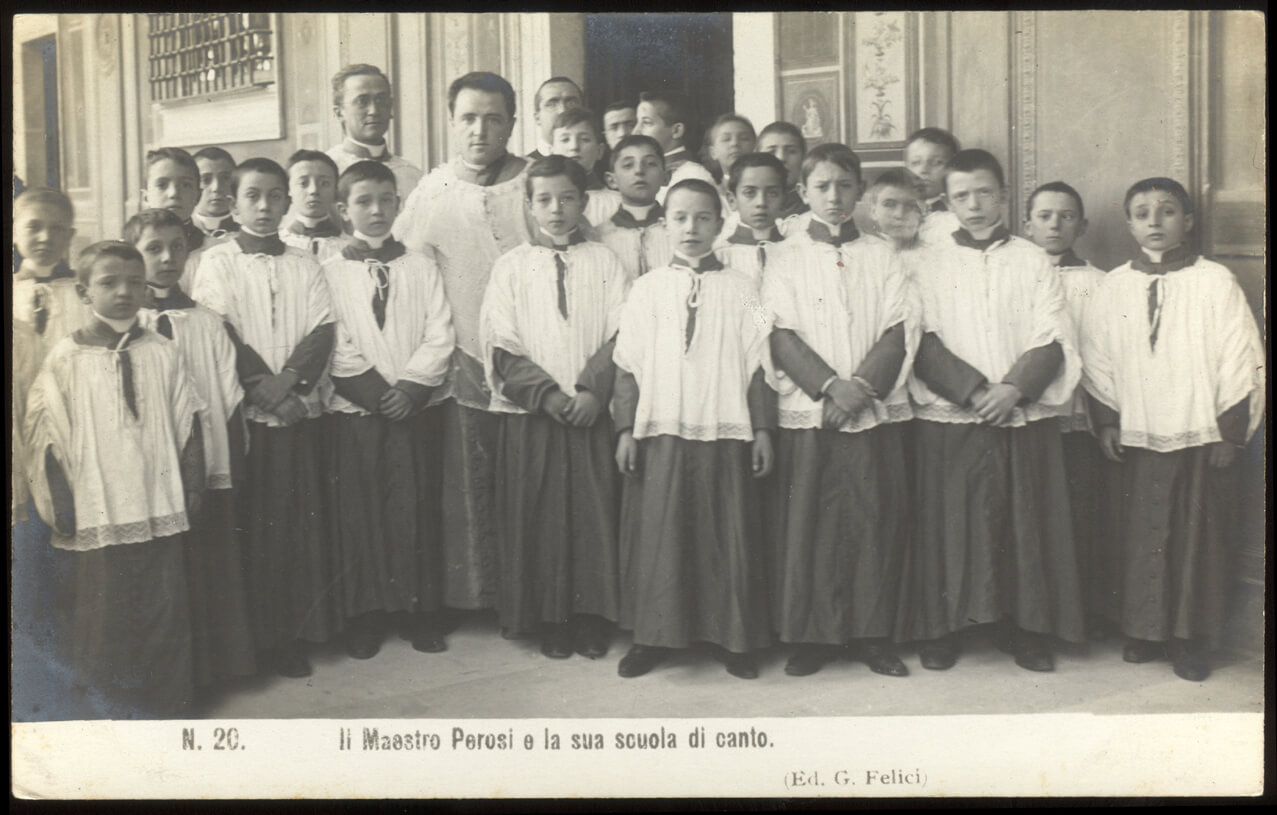Tomorrow marks one hundred and fifty years since the birth, which took place in Tortona, a town in northwestern Italy, on December 21, 1872, “of the great, unforgettable Monsignor Lorenzo Perosi, who was music director of Our Sistine Chapel. […]”, in the words of Pope Paul VI († 1978), pronounced 50 years ago.

“Maestro Perosi,” continued the Pope,
with his marvelous musical talent, was the focal point of the liturgical renewal promoted by Our predecessor St. Pius X. With his admirable compositions and the influence of his genius, Monsignor Perosi restored sacred music to being a sincere, worthy expression of divine worship, freeing it from a certain decadence, which in some cases had struck it in the period immediately preceding him. Perosi was able to implement perfectly the directive line that St. Pius X expressed in the Motu Proprio Tra le sollecitudini.[1]
He lived many places in his life.
Tortona. Here Lorenzo received his first musical lessons with his father Giuseppe († 1908), director of music at the cathedral.
I was born with my hands on the piano; in my house one learned to play before learning to write. As a child I began my life in Tortona in the recollection of my church. My father, an organist, infiltrated my soul with the world of mystical reflections that throbs in the melodies of Gregorian chant and in the notes of psalmody. […] I began to familiarize myself with the German classics as a child. I can say without vanity that I know Bach and Beethoven by heart. From the study of the inimitable Palestrina [† 1594] or Orlando di Lasso [† 1594] I have not lost a single note.[2]
Milan. From 1888 to 1890 by correspondence and in 1892 as a boarder, the boy followed composition studies with Michele Saladino († 1912), teacher in the Royal Conservatory of Music at the Ambrosian City.

Montecassino. From November 1890 to July 1891 Perosi was a teacher of music theory and solfège and organist in the Benedectine abbey. In a letter, the Abbot Niccolò d’Orgemont de la Fontaine († 1896) wrote of him:
When Renzo placed his fingers on the piano, we soon realized that under that fragile casing there was, in addition to a pianist, a true artist whose already profound studies, solid talent and powerful imagination allowed us to predict and extraordinary future from then on.[3]
Regensburg. In 1893, at the famous Kirchenmusikschule Perosi completed the six-month course of sacred music under the guidance of the maestros Franz Xaver Haberl († 1910), the editor of Palestrina’s works, and Michael Haller († 1915).
Imola. Here between 1893 and 1894 Perosi became director of music at the Cathedral of San Cassiano and singing teacher at the Seminary.
Venice. Here, on June 8, 1894, the musician received from the new patriarch, Giuseppe Sarto (the future Pope Pius X), the post of director of music in the St. Mark’s Basilica as well as, having completed his theological studies in the meantime, priestly ordination on September 21, 1895, in the chapel of the Patriarchate.
In an interview for the Turin newspaper La Stampa on March 4, 1902 he said:
Some believe that I devoted myself to religious music only because I am a priest. And don’t think that at 22, that is, at a fairly mature age, completely free of myself after touring half of Europe, I was still a lay person and had already dedicated myself for years only to religious music: I already had in my mind what I wrote later.

In the tradition of Giacomo Carissimi († 1674), the father of the oratorio form, the season of Perosian oratorios began: The Passion of Christ according to St. Mark (1897); The Transfiguration of Jesus Christ, The Resurrection of Lazarus e The Resurrection of Christ (1898); The Birth of the Redeemer (1899); The Massacre of the Innocents and Moses (1900); The Universal Judgement (1904); Transitus animae (1907) and In Patris memoriam (1910), to mention only those performed by renowned conductors, such as Arturo Toscanini († 1957), Bernardino Molinari († 1952), Gabriele Santini († 1964), Antonio Guarnieri († 1952), Bonaventura Somma († 1960) and Vittorio Gui († 1975).
“The little that I am capable of doing”, said the composer,
all comes to me from the inspiration that religion gives me. […] I continue to do what I have done since the first day, that is to apply the technical study and maturity to sing the praises of the Lord as best I can. And the merit that I obtain and for which I am infinitely grateful to Him is to see that the audience, while some think they are applauding me, after all they applaud the divine words and deeds in the translation that I try to make of them.[4]
Rome. Here in December 1898 Pope Leo XIII († 1903) wanted the priest-composer at the Sistine Chapel Choir, first as an assistant director then (1902) as perpetual maestro, a position he held almost continuously until he died, on October 12, 1956, at 5:20 pm, in his apartment in the Palace of the Holy Office at the Vatican.
The musician to five Popes dedicated his work to each of them: the oratorio The Resurrection of Christ to Leo XIII, the cantata Dies iste to St. Pius X († 1914), the oratorio In diebus tribulationis to Benedict XV († 1922), the Missa Redemptionis to Pius XI († 1939), the Mass Pio XII and many motets to the Pastor Angelicus († 1958). The Perosian corpus includes over 50 polyphonic masses, more than 300 motets, over 20 oratorios, as well as instrumental and symphonic music.
But let us stop here, and repeat to the Maestro from Tortona the words Pius XII wrote to him in an affectionate letter dated December 15, 1948:
Those magnificent examples of musical works are known, with which you yourself, scholar and sagacious interpreter of the mysteries of faith, have been able to render with the harmony of song and notes, now powerful, now sweet, all the feelings and states of mind of the pious faithful. So that those who listen to your music are not only strongly transported to the contemplation of divine things, but are also driven to gently receive the impulses of superior grace in their souls.[5]
[1] Paul VI, Homily at the Mass for the 1st centenary of the birth of Monsignor Lorenzo Perosi (September 24, 1972), our translation.
[2] J. Segarra, Amigos y conocidos, Parigi 1908, p. 284-285, our translation.
[3] A. Cameroni, Lorenzo Perosi e i suoi primi quattro oratorii, Bergamo 1899, p. 7, our translation.
[4] Interview to La Stampa, Turin, March 4, 1902, our translation.
[5] In M. Rinaldi, Lorenzo Perosi, De Santis, Rome 1967, pp. 376-377, our translation.


